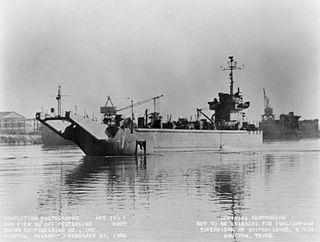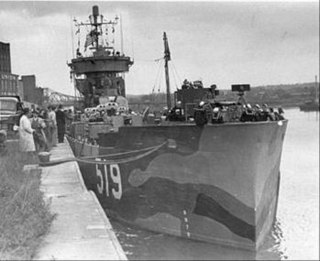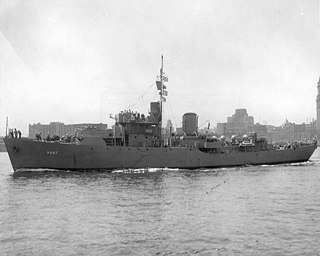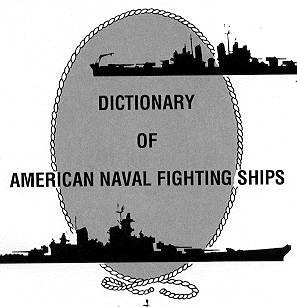| History | |
|---|---|
| Name: | USS St. Mary's River (LSM(R)-528) |
| Ordered: | 1945, as LSM-528 |
| Builder: | Brown Shipbuilding Company |
| Laid down: | 19 May 1945 |
| Launched: | 16 June 1945 |
| Commissioned: | 2 September 1945 |
| Decommissioned: | March 1946 |
| Renamed: | St. Mary's River, 1 October 1958 |
| Reclassified: | LSM(R)-528, 21 April 1945 |
| Struck: | 1 October 1958 |
| Fate: |
|
| General characteristics | |
| Class and type: | LSM(R)-501-class landing ship medium |
| Displacement: |
|
| Length: | 203 ft 3 in (61.95 m) |
| Beam: | 34 ft 6 in (10.52 m) |
| Draft: |
|
| Propulsion: | 2 General Motors non-reversing with airflex clutch Cleveland diesels, 1,440 hp (1,074 kW) each at 720 rpm, 2 screws |
| Speed: | 13 knots (24 km/h; 15 mph) |
| Range: | 3,000 nmi (5,600 km) at 13 kn (24 km/h; 15 mph) |
| Complement: | 6 officers, 137 enlisted |
| Armament: |
|
| Armor: |
|
USS St. Mary's River (LSM(R)-528) was originally authorized as LSM-528. Reclassified LSM(R)-528 on 21 April 1945, she was laid down on 19 May 1945 at the Brown Shipbuilding Co., Inc., Houston, Texas, launched on 16 June 1945, and commissioned on 2 September 1945, Lieutenant Norman E. Wallin, USNR, in command.
A lieutenant is the junior most commissioned officer in the armed forces, fire services, police and other organizations of many nations.

The United States Navy Reserve (USNR), known as the United States Naval Reserve from 1915 to 2005, is the Reserve Component (RC) of the United States Navy. Members of the Navy Reserve, called reservists, are enrolled in the Selected Reserve (SELRES), the Individual Ready Reserve (IRR), the Full Time Support (FTS), or the Retired Reserve program.
On 6 September, LSM(R)-528 sailed for Galveston, Texas, arriving the next day. She sailed for Charleston, South Carolina, on 12 September. However, after two days at sea, she ran into a storm and was diverted to Naval Frontier Base, Burrwood, Louisiana. After the storm, LSM(R)-528 resumed her voyage and arrived at Charleston on 21 September. While there, the ship had her rocket launchers and mortars installed.
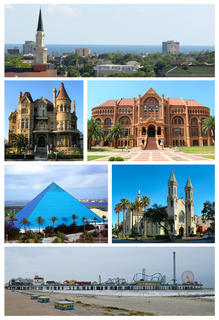
Galveston is a coastal resort city and port off the southeast coast on Galveston Island and Pelican Island in the American State of Texas. The community of 209.3 square miles (542 km2), with an estimated population of 50,180 in 2015, is the county seat of surrounding Galveston County and second-largest municipality in the county. It is also within the Houston–The Woodlands–Sugar Land metropolitan area at its southern end on the northwestern coast of the Gulf of Mexico.

Charleston is the oldest and largest city in the U.S. state of South Carolina, the county seat of Charleston County, and the principal city in the Charleston–North Charleston–Summerville Metropolitan Statistical Area. The city lies just south of the geographical midpoint of South Carolina's coastline and is located on Charleston Harbor, an inlet of the Atlantic Ocean formed by the confluence of the Ashley, Cooper, and Wando rivers. Charleston had an estimated population of 134,875 in 2017. The estimated population of the Charleston metropolitan area, comprising Berkeley, Charleston, and Dorchester counties, was 761,155 residents in 2016, the third-largest in the state and the 78th-largest metropolitan statistical area in the United States.

Burrwood was a community located near the far south end of the delta of the Mississippi River in Plaquemines Parish, Louisiana, United States. At one time the town had an estimated population of 1,000, but today it is uninhabited, with most of its territory fully or partially submerged by coastal erosion.
Departing Charleston on 12 October, LSM(R)-528 sailed for Little Creek, VA, arriving on 14 October. After leave and upkeep, she began shakedown training on 15 October. Completing shakedown training on 15 November, she reported a week later to Commander LSM(R) Squadrons, Little Creek. On 29 November, she sailed for Green Cove Springs, FL, with orders to report for inactivation. LSM(R)-528 was decommissioned in March 1946. Named St. Mary's River on 1 October 1958 for the St. Marys River in northeast Indiana, she was struck from the Navy List on the same day. She was sold on 4 August 1959 to Fleet Storage Corp. Her name disappeared from mercantile list in 1989.

Indiana is a U.S. state located in the Midwestern and Great Lakes regions of North America. Indiana is the 38th largest by area and the 17th most populous of the 50 United States. Its capital and largest city is Indianapolis. Indiana was admitted to the United States as the 19th U.S. state on December 11, 1816. Indiana borders Lake Michigan to the northwest, Michigan to the north, Ohio to the east, Kentucky to the south and southeast, and Illinois to the west.


